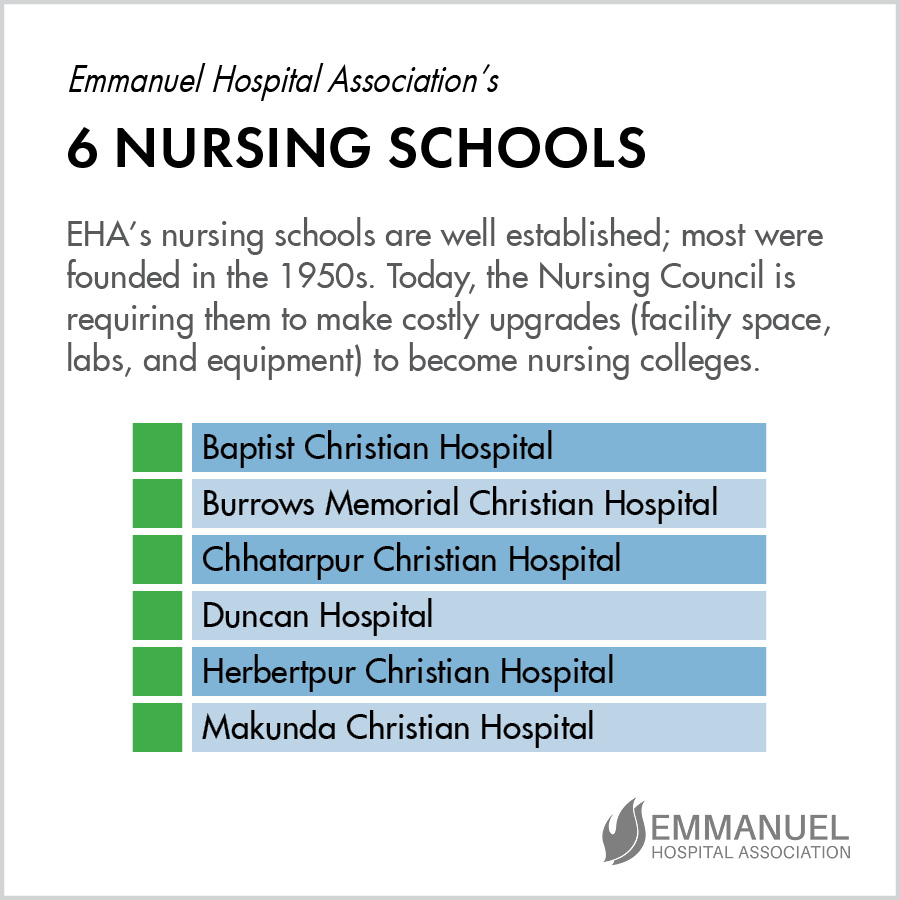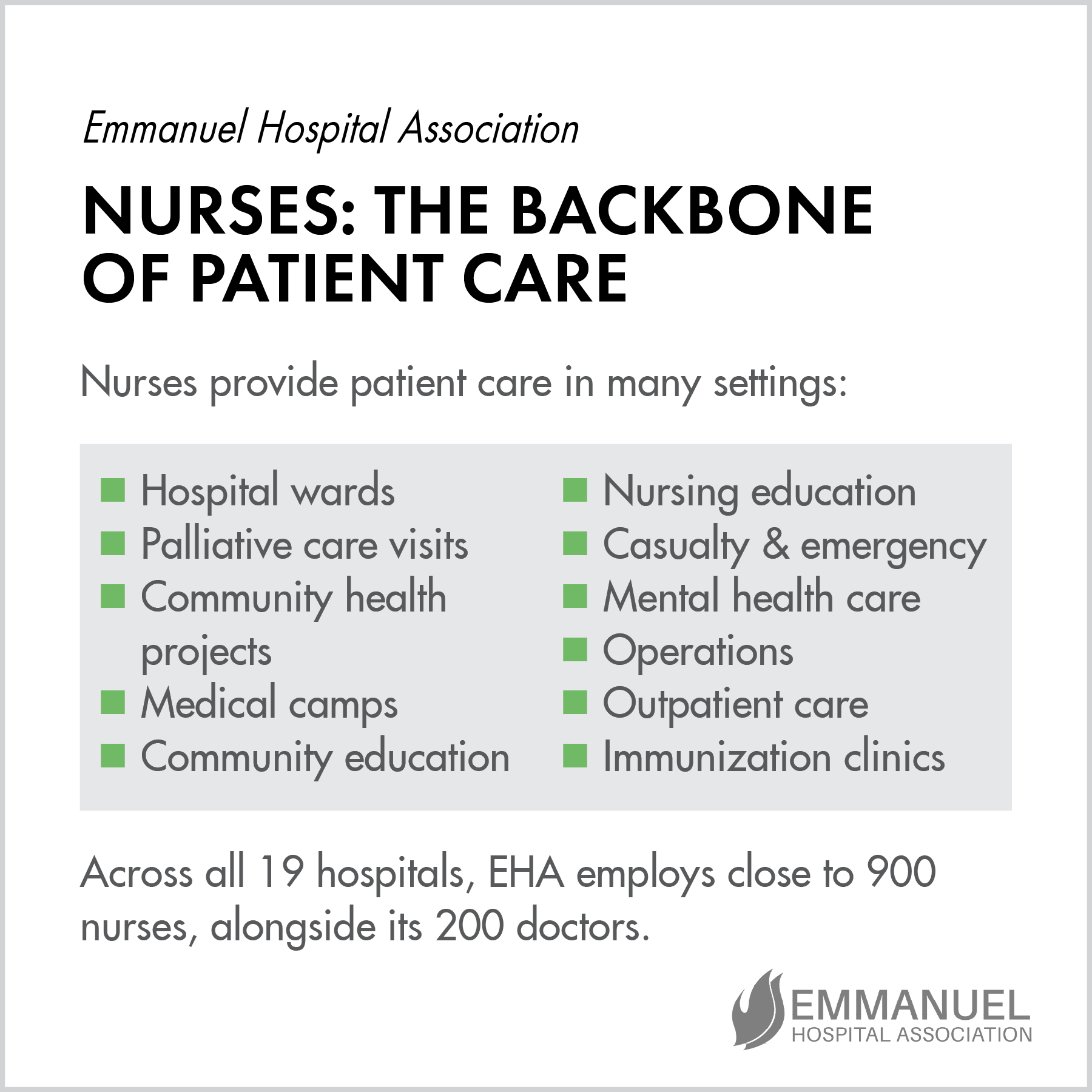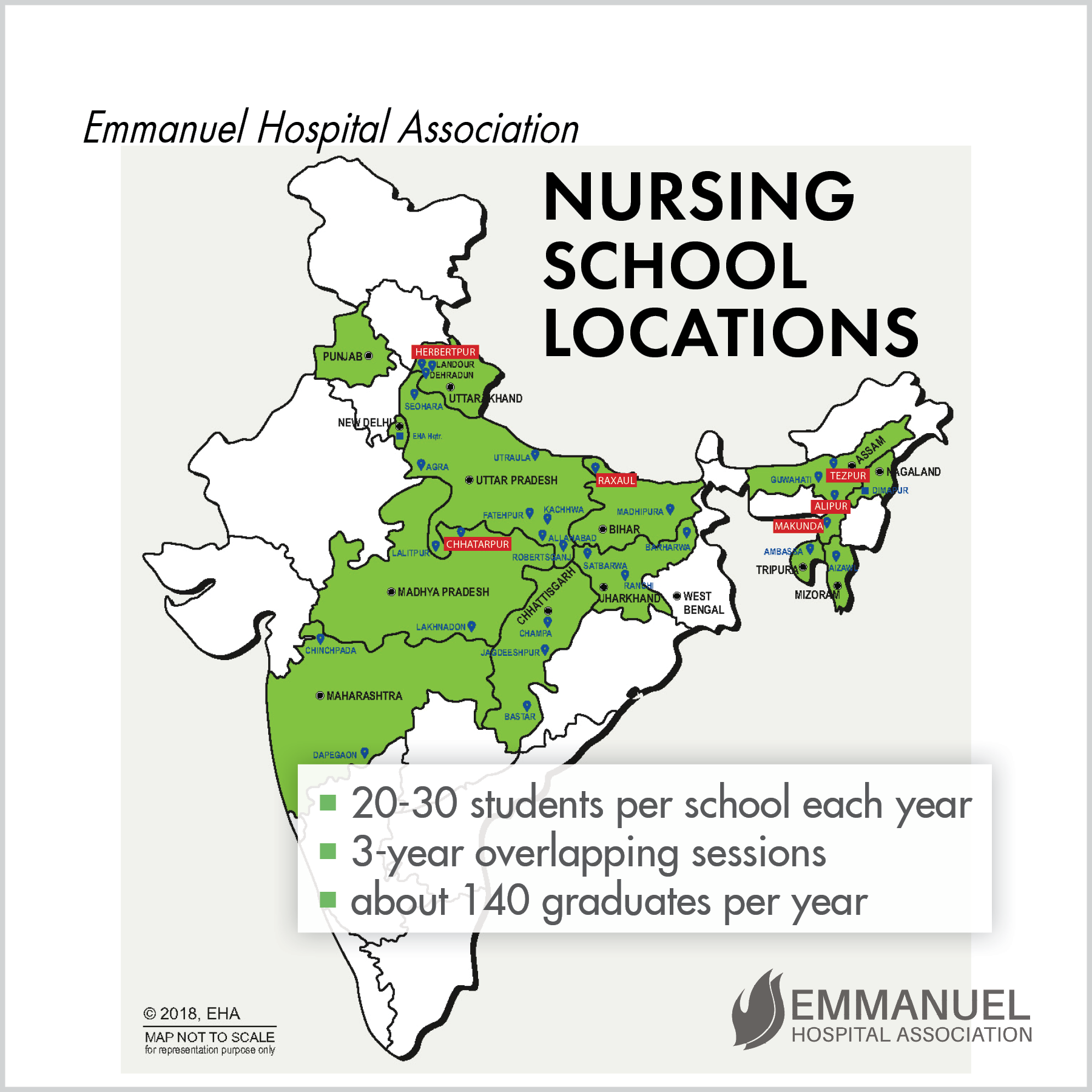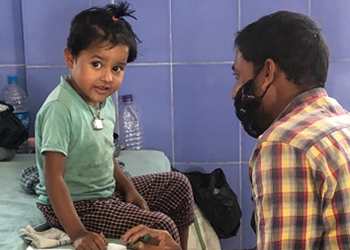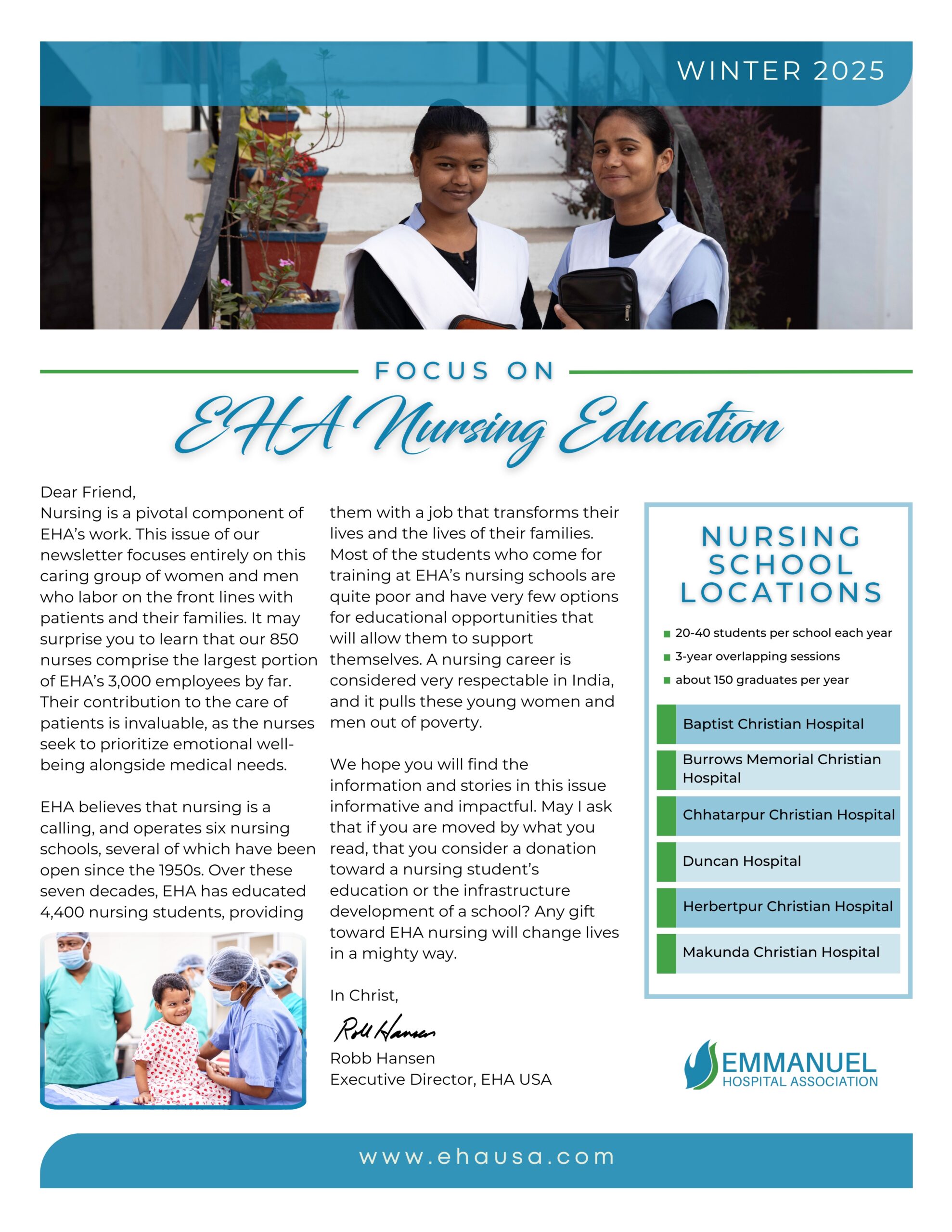Nursing
EHA’s six nursing schools are being required by the Indian Nursing Council to upgrade to Colleges of Nursing and offer a four-year Bachelor of Science degree. This is a significant change for EHA, as the requirements for a College of Nursing are extensive.
Colleges of Nursing must:
Degree ~ Offer a four-year, Bachelor of Science program in nursing, often alongside a three-year General Nurse Midwifery degree
Enrollment ~ Admit 40-60 new students each year
Housing ~ Provide housing for students and staff, including separate accommodations for men and women, as well as a large kitchen and dining hall
Facility ~ Construct a new, separate academic building of nearly 24,000 square feet
(This facility must include four lecture halls, six different types of laboratories, a large multipurpose hall and a common room, offices for staff and a faculty room, a library with 3,000 books, and a garage with a 60-seat vehicle.)
Staff ~ Employ a principal, vice-principal, five professors, and 10 to 20 tutors
Hospital ~ Partner with a 100-bed parent hospital
As you might imagine, these requirements provide a huge challenge to EHA’s small nursing schools, both practically and financially. The chart on the left shows our progress, and the most urgent needs. If you would like to give a donation toward making these upgrades happen, click the button below.
Developing Essential Nurses
EHA’s 6 nursing schools serve a variety of purposes. For the 19 hospitals and numerous community health projects, having a fresh supply of new nursing graduates each year is like a breath of essential fresh air.
For the students, attending a nursing school is often a pathway out of poverty. Nurse graduates are frequently able to help support their parents and siblings as well as themselves.
Obtaining a nursing degree brings respect and status for these young, often poor, people. Many of EHA’s nursing leadership and faculty positions are filled with graduates of EHA’s own nursing schools.
Little Girl Brought Back from Lifelessness
She was only five years old. When Nargiz Farhan arrived at Makunda Christian Hospital, she was seriously ill. She had spent the entire previous night in a seizure with her arms and legs extended, her eyes rolling up in her head, and her teeth grinding. Her parents were very worried and explained she had been coughing for four days and had one swollen cheek and one ear with a discharge. She almost appeared lifeless. During her initial exam, Nargiz had another seizure, and Makunda’s doctors put her on antiepileptics and moved her to the High Dependency Unit.
After the next seizure, Nargiz experienced a cardio-respiratory arrest. The staff revived and intubated her. The next day the nurses noted that Nargiz had muscle spasms, and when a small abrasion was discovered on her forearm, the doctors diagnosed her with meningitis and tetanus. They gave her given tetanus immunoglobulin, and the doctors and nurses prayed for her healing.
Twelve days into her hospital stay, Nargiz’s heartbeat slowed to the point where CPR was needed again. The nurses stayed by her side, and she was soon able to come off the ventilator. But she still was not processing the stimuli around her or responding in any way. On day 22, Nargiz spoke and the nurses cheered. Many sessions of physiotherapy helped Nargiz regain the use of her limbs. On day 28 she was able to flex her knee and sit up.
After a total of 34 days in the hospital, the little girl was able to mostly feed herself and walk with support. She was able to respond to conversation and was released to go home. The doctors and nurses of Makunda were thrilled to see God’s healing hand bring this child back from the brink of death.
A Pathway Out of Poverty
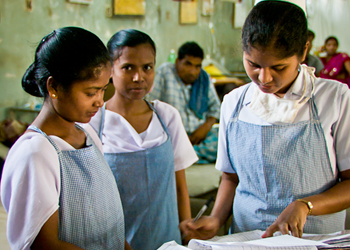
While EHA is known as an association of hospitals, they also have a focus on nursing. The majority of EHA’s six nursing schools were begun in the 1950s or 1970s. The mission for these schools is to provide high-quality training to young people from remote areas and to prepare competent nurses to provide holistic care. Each school takes 20 to 30 students in overlapping 2- to 3-year sessions, and the graduates are eagerly awaited to meet the ever-growing need for nursing expertise in EHA’s hospitals.
Developing Values and Empathy
Typically, the training process for both doctors and nurses in India is goal-oriented with a focus on self-promotion: how to pass the exams, get a great job, and make as much money as possible. But at EHA’s nursing schools, the instructors strive to teach their students values and develop them as people.
Students learn how to demonstrate these values in their speech, attitudes, and actions, and how to be caring and compassionate with all patients. In their second year, the nursing students go to visit and learn from another hospital outside EHA, and they are immediately recognized as being different. Even though the pay is lower, many of these nursing students choose to stay within EHA upon graduation, but those who do go elsewhere are sent out as salt and light.
Out-of-Reach Tuition Costs
A year of nursing school costs 65,000 rupees, or $1,000, per student. Food and housing brings the cost to 100,000 rupees, or $1,500. This wouldn’t pay for one class in a US nursing program, but it is significantly more than many Indian families can raise, so promising students often receive partial support from the school. After graduation, they complete a work-service commitment with EHA to pay off their no-interest loan.
Building a Better Future
In addition to helping with tuition costs, gifts from EHA supporters also ensure that facilities are adequate for the needs of the students. Burrows Memorial Christian Hospital, Madhipura Christian Hospital, and Herbertpur Christian Hospital are currently expanding their nursing school facilities. The need for more space is critical, both to accommodate current students, as well as to take on more. Such projects require capital funding from outside EHA, and one-time gifts toward construction are highly valued.
Becoming a nurse provides a pathway out of poverty for these women, and they typically have no other option for schooling that will help them obtain a professional job like nursing. And often, once a woman becomes a nurse and begins to earn money, she will help support her parents and siblings. When supporters help a young woman become a nurse, they are not only helping her and her future patients, they are helping a whole family rise out of poverty.
Overcoming Enormous Odds

“You can be anything you want to be.” Kids in America hear that all the time, but an Indian girl is not likely to ever hear it. Many Indian girls never complete high school, let alone higher education. In rural states, almost half will not even learn to read fluently. Education is skewed toward boys, since most girls will “just” become wives and mothers. It’s worse for poor families with several daughters—girls are a liability with low earning potential, and parents often still have to pay a dowry for them.
But Suman was willing to battle these odds to succeed. She was the youngest in a family with four daughters and one son. Her father was a day laborer, and when her mother became ill, the medical bills plunged them into poverty. Her father had no choice but to sell their land and livestock to pay the medical bills—and since he couldn’t afford their school fees, he sent Suman and one sister to a children’s home. Life was difficult at the orphanage. There were often food shortages and electrical outages, which meant studying for exams by candlelight.
Suman had a dream for her future. “When my mother was in the hospital, a nurse helped us. I decided to become a nurse so that I could help people too,” she explained. She applied to the School of Nursing at EHA’s Herbertpur Christian Hospital, and she was the first candidate accepted from the children’s home.
From its beginning, the school had set aside places for girls from poor families, to challenge the low status of women in Indian society. Many of EHA’s nursing students come from disadvantaged families, and becoming a nurse is an escape from poverty for them. They can get secure jobs with decent salaries, bringing a change in status to their families.
Suman’s story has a happy ending. Through the hospital, she reconnected with her family. Her father is grateful for the training she received. “I never imagined that one day my daughter would be a nurse. I could never support my children for such courses. I am thankful to God and to everyone who has helped her.”
Providing funding for a nursing student to get through school not only helps that young woman, it helps her family as well. If you would like to support a nursing student, click here.
Read About Nurse Education
Click on the newsletter below.
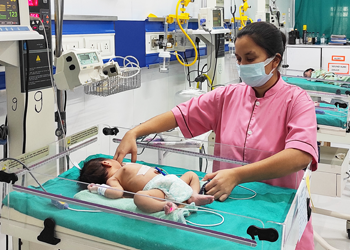
About EHA’s Nursing Program
The nurses in EHA make up the backbone of the workforce in delivering quality and compassionate care to patients. Often viewed as the face of EHA, nurses have built trust with their patients through delivering holistic care to both patient and family, through patient advocacy that honors patients’ values, and through developing competency through fellow instruction. The Nursing Department is one of the largest departments in Emmanuel Hospital Association, comprising nearly 900 personnel who work under the Director of Nursing, the Nursing Superintendent, and the Principal.
Serving in various capacities, nurses must handle the needs in the in-patient departments, out-patient departments, operating rooms, critical care units, and community projects. They use a five-stage problem-solving approach, involving assessment, diagnosis, planning, implementation, and evaluation.
Nurses are recruited from the six nursing schools run by EHA hospitals as well as from outside the institution. These schools were started with the goal of helping young men and women in their personal and professional development so that they can make the maximum contribution to society as well as be efficient nurses. Nursing education through these schools prepares young, committed nurses to show God’s love and provide compassionate care. Every year about 140 nurses who have earned their diplomas from the six schools join the Nursing Department.
Continuing education of these nurses is also a key component of the Nursing Department. Due to EHA’s initiative in motivating, encouraging, and supporting nurses in further training, many nurses go on to get Bachelor’s and Master’s degrees. Nurses are also encouraged to participate in ongoing clinical trials and other research studies. Many EHA hospitals offer in-service education on a regular basis to build knowledge and skills among nurses. Sometimes special conferences and workshops are arranged for further training. All of these measures ensure nurses are always growing in skills and knowledge they can use in their care of patients.
The strength of the Nursing Department at EHA is its motivation to transform people through education and care. It is deeply committed to patient care as well as keeping up with changing trends in healthcare. Nursing is the heart of EHA, which supports and provides comprehensive patient care at all levels. Without the excellent nurses produced by these nursing schools, the field of medicine would remain handicapped. EHA is proud of the dedication, commitment, and tireless effort of all of the nurses who promote and maintain the health of their patients.
